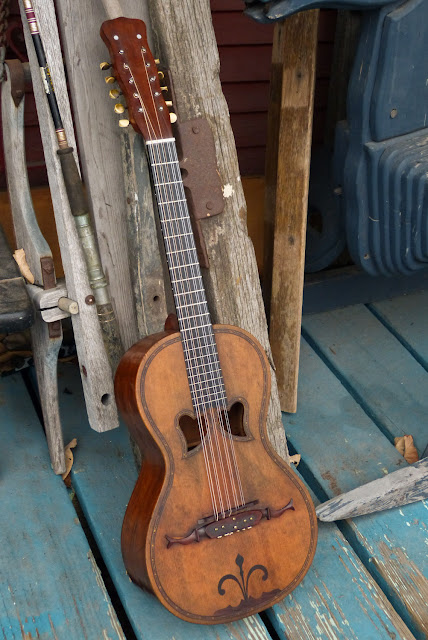1920s Viola da Terra
This viola da terra was taken in trade for some work and I haven't worked on one since 2012 so it was a bit exciting to have one in the shop again. I'm pretty sure this particular instrument is American made due to the 1920s tuners, though its quite traditional in build, otherwise. It's a little nicer in spec than average compared to the old ones I've seen on eBay from time to time, though, and has a solid spruce top, solid mahogany back, sides, and neck, and a thick ebony fretboard. The bridge is an orange-ish mystery hardwood that's an awful lot like rosewood.
Traditionally these are strung 3-3-2-2-2 in 5 courses and tuned ADGBD or ADGBE like a 12-string guitar minus the low E. I've removed two of the tuners (as one was damaged, anyhow) and strung it 2-2-2-2-2 in 5 courses and retuned it to a delicious-sounding GDGDG open G tuning with steel gauges 18/42w, 13/30w, 10/22w, 13/13, 10/10. This same set can be retuned to the ADGBE stringing as well, though, if desired. It's playing spot-on with 1/16" action at the 12th fret.
Overall dimensions are like an 1880s parlor guitar -- but slightly deeper and with a shorter scale. It has an 11" lower bout, 4" side depth (which = fuller sound), and 21" scale which puts it into terz/tenor guitar territory in terms of fret spacing.
Overall dimensions are like an 1880s parlor guitar -- but slightly deeper and with a shorter scale. It has an 11" lower bout, 4" side depth (which = fuller sound), and 21" scale which puts it into terz/tenor guitar territory in terms of fret spacing.
Work included regluing the bridge, cutting a new fully-compensated rosewood floating bridge (note how these use a fixed "tailpiece" bridge and a floater in front of it), a refret from 1 to 12 and then a fret level/dress, general setup, tuner modification, and side dot install.
There's a lot of usewear evident (especially on the top as these are traditionally unfinished or simply sealed on the top) but it's in overall excellent shape. There's one tiny hairline crack (repaired) on the back and one tiny one on the side (also repaired), but it's otherwise unscathed structurally.
The bone nut is new, too, and it's 1 5/8" wide over a big old v-shaped neck profile.
I installed new jumbo frets from 1-12 and left the originals after that. The board had minor warp to it, but rather than level it off before the refret (which would've been a little invasive on this instrument) I simply leveled the frets off afterwards.
There's still tons of meat left for many more level/dress jobs. I added side dots, too.
I left the original frets in the fretboard extension as I was certain it would be a murky situation to refret it nicely if I started. On these instruments the frets and board are level with the face of the top and these are bar frets, too, so I didn't want to open that can of worms. Besides -- is anyone really going to play up there, anyhow? I know I won't!
The heart-shaped soundholes are traditional and look excellent. I love the way the furniture-trade purfling has been transported 1/4" inboard of the sides, too.
Originally the 6 brass screws were in a line and used to hold loop-end string-ends which would then curl-over and under the bridge in the same manner as my simpler "ball-ends behind" setup provides.
When I first strung this instrument back up I tried for a 6-course setup but that was too cramped at the nut and so I went at it again and strung it for 5 courses with a new nut and floating bridge.
There are 6 obvious "notches" in the bottom of the bridge for string-loading, though a few old worn slots exist as well and can be used in addition to the 6. I've willy-nillied the string loading to get as close to the slots on the bridge as possible with the most even string spread possible.
The screws aren't really necessary, but they were there to begin with so I left them in peace.
I've always loved the little decorative details that Portuguese instruments tend to have.
The back is lightly arched and, though it's not obvious in these pictures, the mahogany has a good amount of light figure to it. It looks great in good sun!
The 1920s tuners work just fine and the builder recessed them into the back of the headstock so the shafts would poke out the top. I love that nice "volute" just below them, too.




















Comments